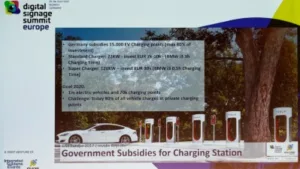We went along to the DSS Europe in Munich this year to appear in a panel session. Because of other commitments, we were only able to attend on one day. The event included a small exhibition and we’ll include a brief report. Because the event is so soon after Infocomm, there was little news from the major brands. Much of the day that we attended was about overall systems and software, especially in retailing. We decided not to cover these. The event looked well attended although there wasn’t a lot of traffic in the exhibition area.
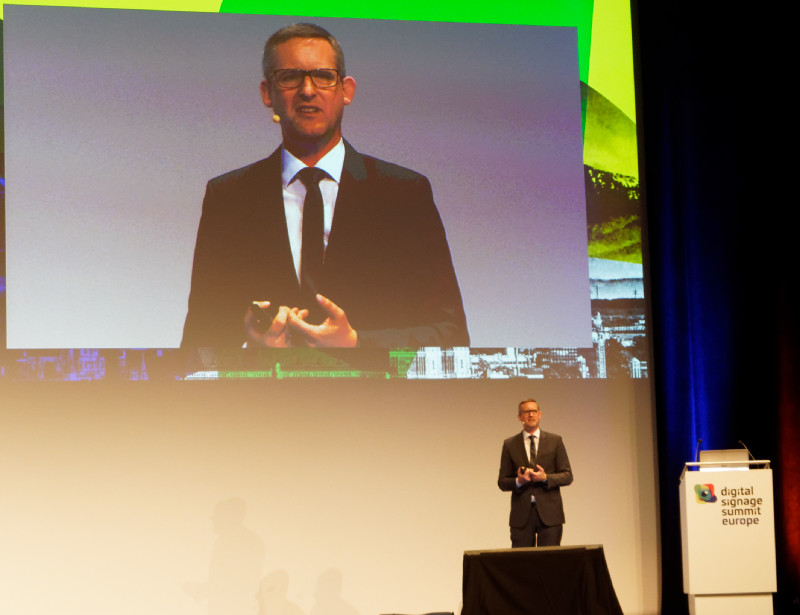
The first speaker we heard was Florian Rotberg, from Invidis and one of the organisers (and founders) of the event. He spoke about “Smart Cities” and started by identifying five things you need to have a smart city. They are:
- An infrastructure of services for businesses, citizens and public authorities
- Communication (including Wi-fi)
- Alternative Energy (especially solar)
- Safety (with good lighting and CCTV coverage)
- Out of Home digital signage and advertising
Rotberg looked at an example of Dubai, which is “very good at selling dreams”. The authorities are determined to try to make it a happy place and good marketing. Dubai, as part of its smart city initiative and build up to Expo 2020.
The Dubai authorities make three levels of data available. There is some general data is available to the public or via open contracts to companies including, for example, traffic data. In addition to the public and company data, government to government data is also available.
Singapore is Good at Simulation
Rotberg said that Singapore wants to be first truly global smart city and see itself as a “living laboratory”. The authorities are continually looking at how to add value to service using smart data. In Singapore, public housing is for 80% of people and so there is a lot of interest in that area. The local government cares about air quality, energy, and transport.
An example of the use of data and simulation in housing, there is a good simulation that has been developed of individual public housing. Prospective tenants can use simulation to check, for example, for handicapped access, sometimes using virtual reality. In general, in Singapore, simulation is well developed.
In Santander in Spain, a project was undertaken to install parking sensors to allow drivers to find empty spaces, but this was done ‘the hard way’ and authorities drilled holes in the streets for this. The sensors can also measure noise and pollution so that it can be mapped.
There are differences around the world, for example, many Europeans don’t accept widespread CCTV monitoring – you need to check the cultural impact of data collection. In Europe, technology development is often what is culturally accepted.
The LinkNYC project is interesting to Rotberg and the project is now expanding out of New York to ten other US cities. It’s built around offering access to Wi-fi as the base service. Now there are some new totems with touch screens and the developers are using totems for dynamic data and applications.
The InLink project in the UK is somewhat similar and the scheme is an evolution of the phone box, which was really abandoned because of the inability of wheelchair users to access them. The project started last week at the end of June 2017.
Transit and Electric Car Charging
Transit systems are important in developing smart cities because of the scale and the number of people – it’s where most smart city projects start.
Looking at some other projects, there are now 17 “Smart Palms” in Dubai, mostly built around phone charging and Wi-fi access. They are still rolling out slowly.
Elsewhere, electric car charging points are an interesting place to communicate and to collect a lot of data. Volta charging is situated in front of Whole Foods stores and offering free charging. Now, of course, Amazon will own Whole Food Markets. Volta claims the largest charging network in the US.
Germany is subsidising 15,000 charging points (at up to 40% of the cost), but there is a €7,000 – €10,000 cost for each standard station (or €30,000 for a ‘Super Charger’), which is a barrier to wider roll outs. Germany is aiming for a million electric cars and 70K charging points by 2020.
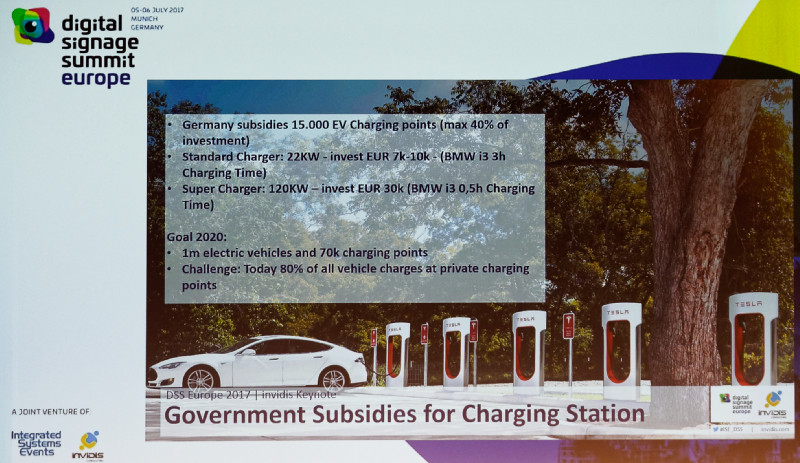 Germany is subsidising charger building costs
Germany is subsidising charger building costs
An interesting idea is the ‘Wattway’ which puts solar panels on the surface of a road. It turns out that even in busy urban environments, 70% of time the road surface is not covered and in general, roads are uncovered 90% of the time. Wattway, which was developed in France, and the firm claims that 20m2 of its panels would meet the energy needs of a home.
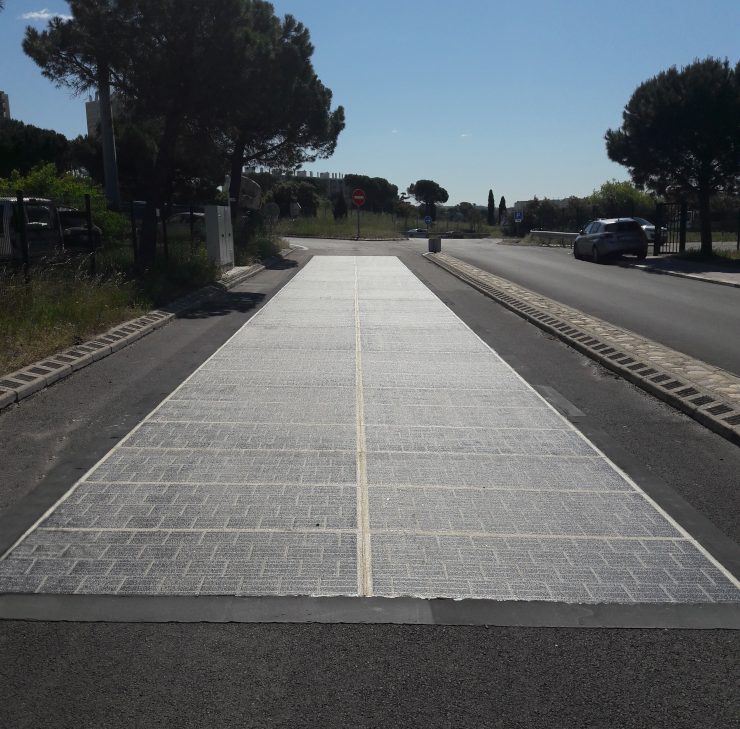 The Wattway system puts solar cells in roads and is being developed in France
The Wattway system puts solar cells in roads and is being developed in France
Bike Rental Needs Docks
If you look at urban bike rental schemes, it turns out that information drives usage. However, you really need to understand how the bikes will be used. For example, in Barcelona bikes were only rented at the top of the hill and only rented to go down. For this reason, the city changed to eBikes.
In China, there has been a lot of chaos because a number of companies have tried to develop networks very quickly and have not used docking stations, the bikes being left anywhere. However with 450,000 bikes put into Shanghai in six months with no infrastructure has caused havoc, with huge piles of bikes in parks and other placed. In contrast, London has 13,000 bikes, rolled out over years.
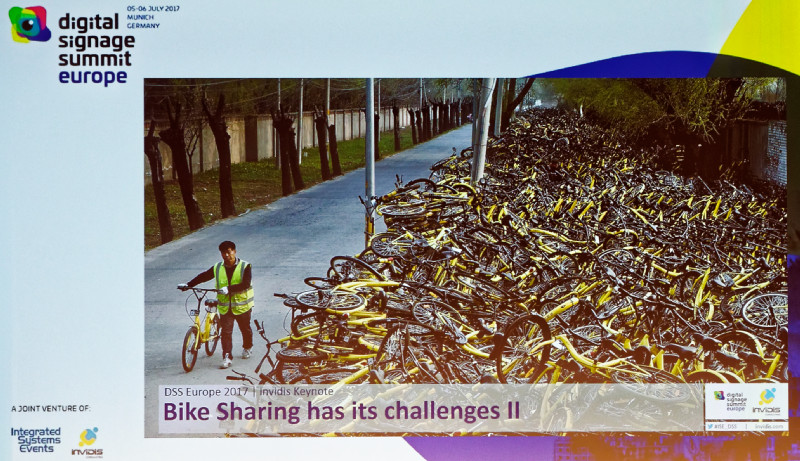 In China, bike rentals don’t use docks and the scale can cause chaos.
In China, bike rentals don’t use docks and the scale can cause chaos.
In New York City there are more than ten million rentals from just 12,000 bikes. Rotberg said that systems must have docking systems.
However, Rotberg said, nobody wants to live in a computer city and it’s important that you don’t forget the people.
Key points for smart cities are
- Object and individual recognition
- Location awareness
- Sensing
- Transactional technology (which is not too easy, he said).
- Connectivity
You also need integration of different systems with no “silos” or barriers between different systems.
So, he concluded, there is a huge potential for smart cities, but data is the core of the system and comes first. Administrators and citizens need to be sure that they get clear benefits from smart systems. Consumers don’t get a real benefit from receiving advertising – there has to be something else to benefit them.

